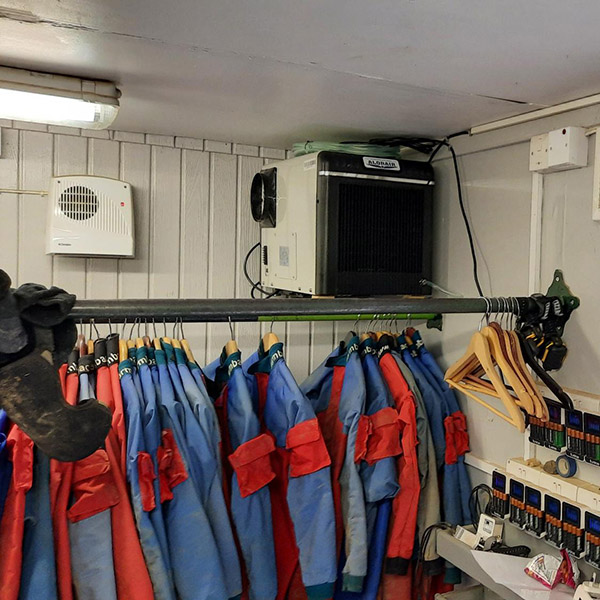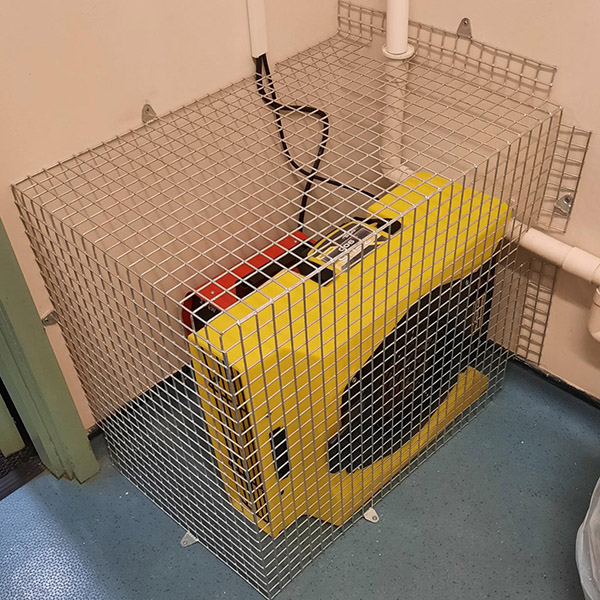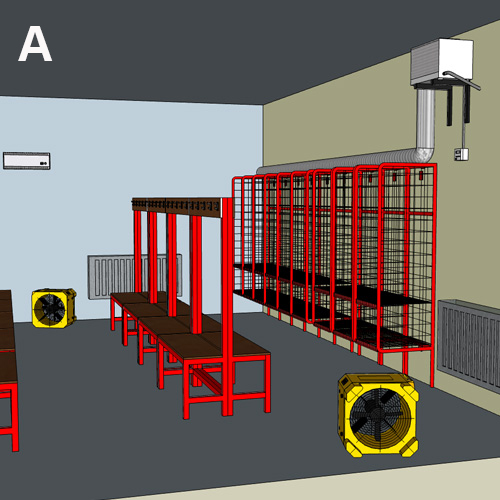
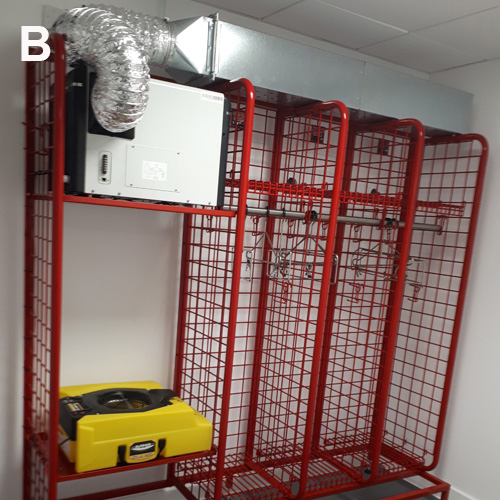
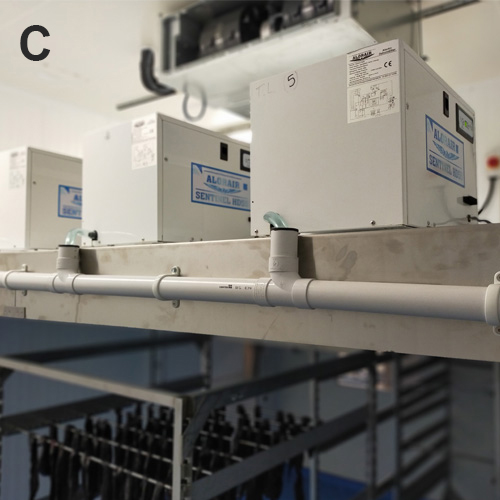
A. Schematic design to dry clothing and PPE.
This image shows a schematic design which we have adapted for several applications where it is necessary to dry clothing and PPE. The unit is designed to maximise efficiency whilst being energy efficient. The dehumidifier is set to work on a humidistat and the output dry air is directly discharged via ducting to impinge on the wet clothing. The efficiency of the drying is increased by controlling the temperature and increasing air movement using one of our air movers. We can either make use of existing heaters in the room or supply a separate heater that we will link to the Humidistat. Once the clothes are dried the RH in the room will drop and the system will turn off automatically. This efficient modular design will save you time and money and ensure you provide your staff with warm dry protective clothing. We are also able to upgrade or add to existing drying rooms to make them more efficient by reducing energy consumption and drying times.
B. An installed drying room.
This image shows an example of an installed drying room. Each system can be custom designed and sized to suit the space available. This room was commissioned by Bristol Airport to quickly dry the outdoor wear and uniforms for the staff. We work with a locker manufacturer who will construct the open mesh lockers to our drawings. We attend site and install the system and fully commission the room.
C. Bespoke hygienic designed room.
This image illustrates a bespoke hygienic designed room which is suitable for applications in the food and pharmaceutical industries. This room is designed to control the environment for the whole room to set humidity and temperatures. A plenum ceiling is installed, and all the dehumidifiers and temperature control equipment is neatly above the ceiling. Air is forced around the room using variable speed fans in a bulkhead. In this room a reverse cycle air conditioning unit is installed which can heat or cool the environment as required. The variable speed fans ensure that the correct air movement is always achieved in the drying zone whilst the dehumidifiers control the humidity. The control panel can be located remotely, and all variables can be changed or monitored from this panel. The system is scalable to suit any sized space.
Mobile drying unit.
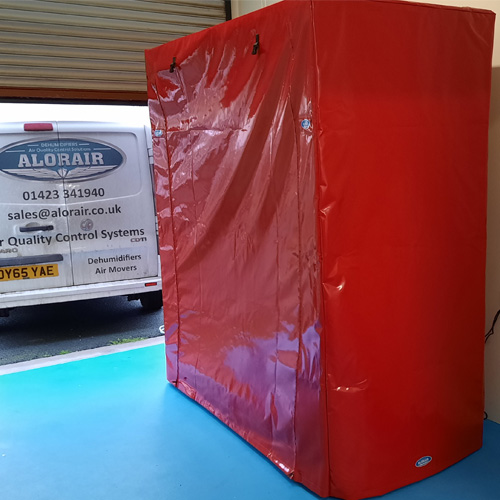

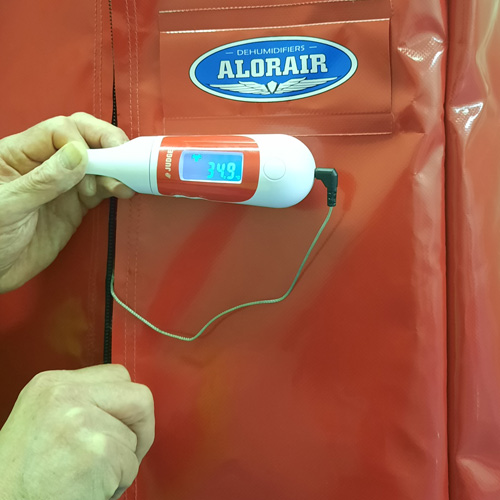
A new mobile drying unit from AlorAir Solutions UK Ltd can be used to dry PPE using a combination of air movement from fans, heat from fan heaters and water removal by dehumidifiers.
The water is pumped away via a condensate pump. A full length drip tray underneath the clothing will capture the water drips and feed that to the pump, the water collected from the dehumidifier also gets fed to the same pump, which only activates once there is enough water to pump away and is not continuously working.
The fan is linked to the dehumidifier so only turns on when a high relative humidity is detected (wet kit) and will only turn off when the humidity point is reached (dry kit) – the RH levels on the dehumidifier can be set so more or less drying can be obtained as required. The fan heater works on a timer box allowing times of one, two, three or four hours to be selected, depending on what is in the mobile drying unit, and how wet it is will depend on the time chosen – but four hours will be a maximum – this helps stop the heating being left on continuously – therefore making it more energy efficient.
A step bar has also been added onto the base of the frame to help users hang the kit and not bend or stress the mesh, which has been designed to allow boots to sit on and dry.
West Midlands Fire Service (WMFS) has recently ordered two drying units to hang their dry-suits after water training. These units are taller than normal, allowing for the dry-suits to be hung without them dragging on the bottom of the dryer. WMFS also specified a larger width than usual, enough for 13 suits with approximately 200mm between each one, which makes the unit 3m wide and 2.9m high. These should be ready at the end of February.
The drying units take approximately eight weeks to manufacture from confirmation of order and take approximately one day on site to build.
Case studies.


South Wales F&R – Drying Rooms
A: Problems – Doing both reactionary and planned works at numerous of the South Wales F&R locations on their drying rooms as well as coming up with solutions for new drying rooms.
B: Solution – Replacing old dehumidifier units with smaller and more powerful Alorair units, upgrading underperforming drying rooms with additional heat or air movement, designing new drying room solutions for sites keeping usability as easy as possible whilst also keeping the efficiency as high as possible linking in control measures, in the way of humidity sensors (humidistats), thermostats and timer switches.
To ensure items of kit and clothing are dried as quickly and as efficiently as possible.
“We have been using ALORAIR to install dehumidifiers, air movers and heaters for the past 18 months and they have been a pleasure to deal with. Simon, the sales and marketing manager knows their products inside out can design the systems to suit any need. We have installed their products at 6 busy sites throughout South Wales all with excellent drying results. We have also seen a significant reduction in energy usage at these sites due to the built in moisture sensors only enabling the units when necessary. Every time we have contacted ALORAIR where our existing systems have broken down, they have arranged for an engineer to design and fit a new system within 48 hours leaving us with very little down time. Whenever we have needed any advice or technical help, Simon has been at the end of the phone happy to help.”

Premier Foods – Drying Room for Air Filters
Premier Foods have a number of Air filters around the factory filtering the incoming air into the factory. These filters need to be washed and changed on a regular basis to ensure the incoming air is clean and fully filtered, and also that sufficient air can pass through the filters to get into the factory.
Problem: The drying times of the filter was taking approx 72 hours to dry naturally – this was too long and so either they had to reduce the drying times or invest in a number of new filters so correct rotation and cleaning could be achieved.
Solution: AlorAir have offered for a short term the hire of the AlorAir portable drying system, initially trialled to prove that we could reduce the drying time down from 72 hours. The results were conclusive and got the drying times of the filters down to 12 hours using the combination of dehumidification, air movement and heat in our mobile unit. We said we could further reduce the drying times down if there was a dedicated drying room, this would also allow for more filters to be dried at any one time (which they need as only 6 filters can be dried currently at any one time due to the size). Having the dedicated drying room would also be more efficient than the mobile unit as well and would also be more hygieneic as well as this can be easily sprayed down and cleaned should needs be.
Conclusion: 2 designs and quotes have been submitted for static drying rooms at Premier Foods, to resolve the drying times problem as the mobile drying system is to be returned to AlorAir for shows and demonstrations. We are just awaiting the sign off so we can proceed with the order.
FOR MORE CASE STUDIES CLICK HERE
“The drying rooms have been fabulous here! Extremely efficient, and they have helped us out making our sessions much more comfortable for the users.”
Annouska Evans
Centre Manager
Charterhouse Outdoor Centre
